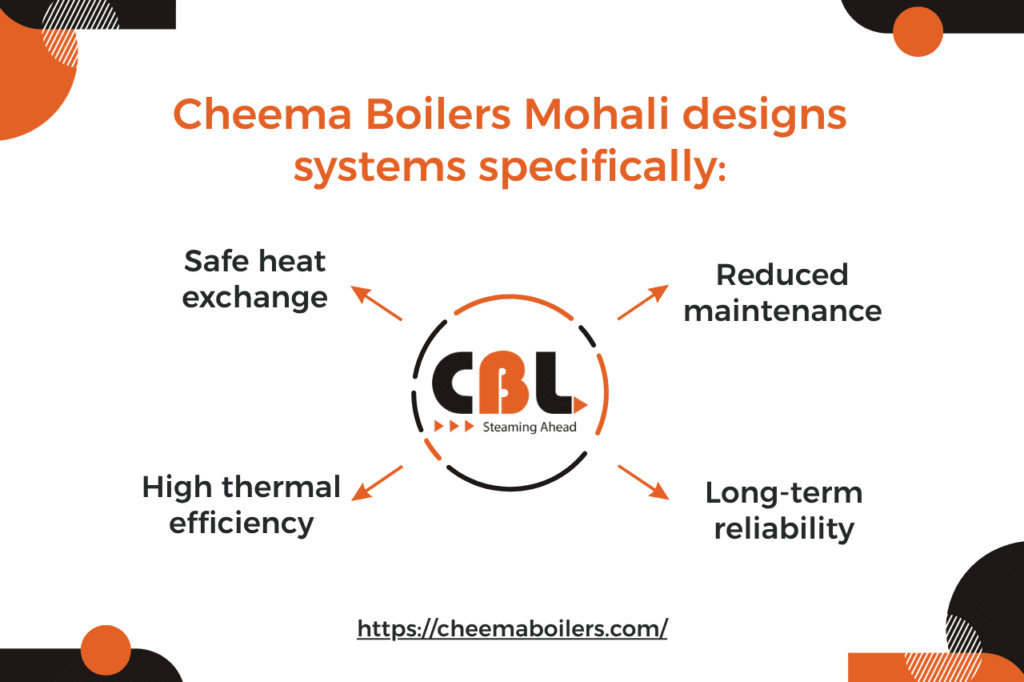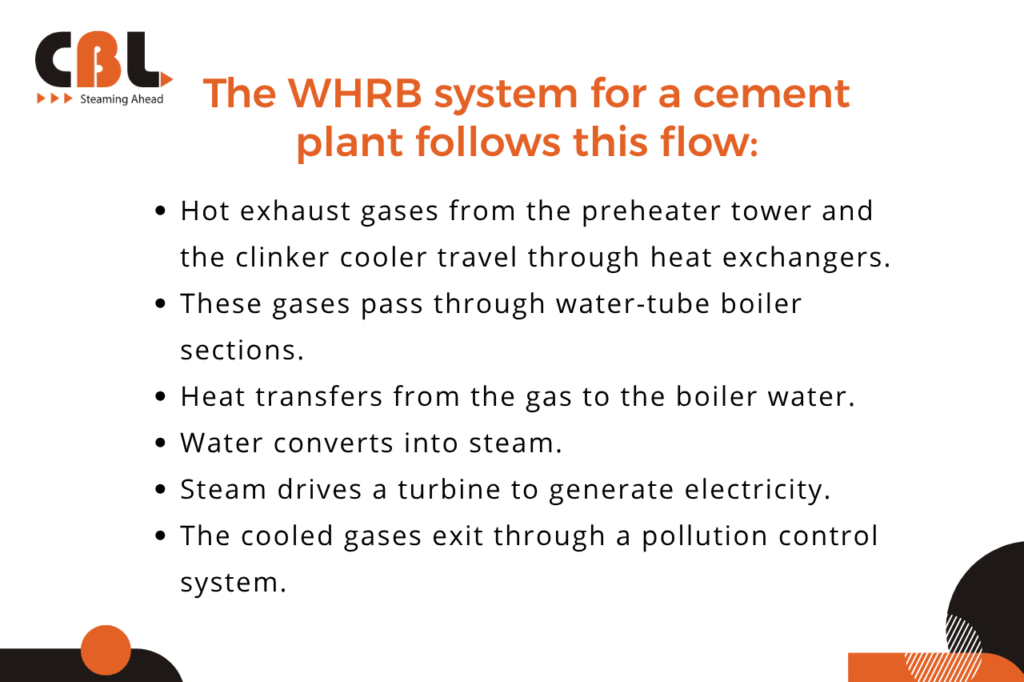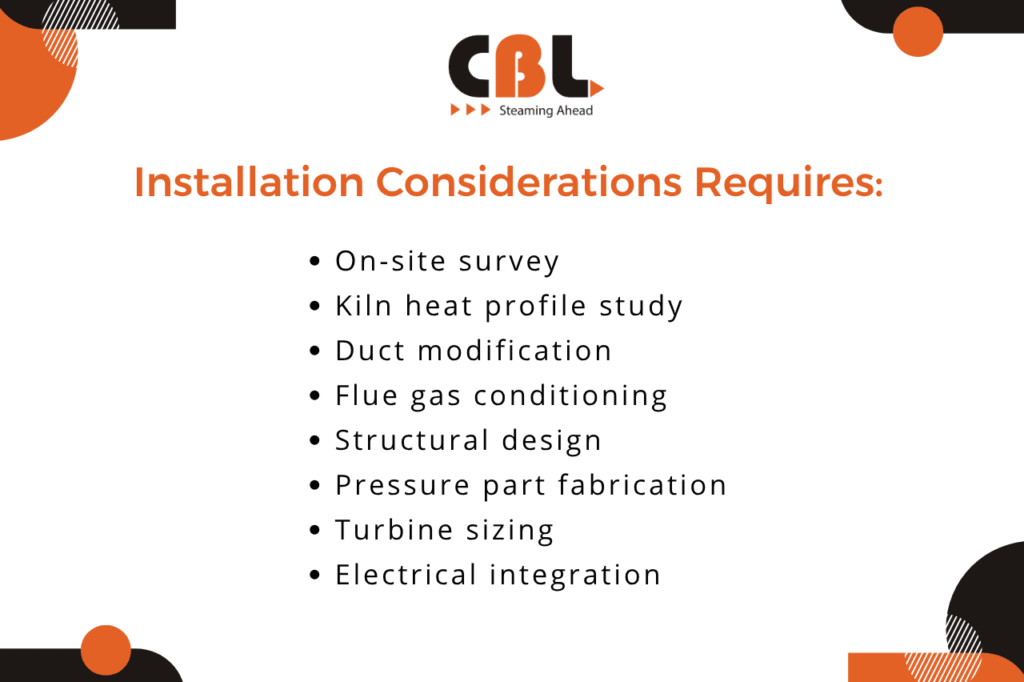India’s cement industry is one of the largest energy consumers in the manufacturing sector. With rising energy prices and stricter sustainability requirements, cement plants are under tremendous pressure to reduce operational costs. One of the most effective solutions is installing a Waste Heat Recovery Boiler (WHRB).
As a leading waste heat recovery boiler supplier in Punjab, Cheema Boilers (Mohali) has delivered advanced WHR systems to some of India’s largest cement manufacturers. This guide explains how WHRB works, why cement plants need it, available technologies, costs, benefits, and ROI.
This is not just a technical article — it is a complete decision-making guide for cement plant owners, engineers, and project consultants.
Why Cement Plants Need Waste Heat Recovery
Cement plants are unique because they operate at extremely high temperatures — often above 1,400°C in the kiln. This produces massive amounts of waste heat that normally escapes through:
Preheater exit gases
Cooler vent gases
Kiln exhaust
Clinker cooler discharge
Traditionally, this heat was wasted.
However, with a Waste Heat Recovery Boiler, this heat can be converted into:
Free electricity
Process steam
Hot water for utilities
Reduced fuel consumption
Lower greenhouse gas emissions
For a typical 6,000 TPD cement plant, WHRB can generate 12–20 MW of power — enough to cover 30–40% of the plant’s electricity needs.
Understanding WHR Boilers (WHRB)

Types of Waste Heat Recovery Boilers Used in Cement Plants
A Waste Heat Recovery Boiler is an industrial system that captures waste energy from hot gases and converts it into usable heat or power. The WHRB is specially engineered to operate with low-density, dusty, and high-temperature cement plant gases.
It ensures:
Safe heat exchange
High thermal efficiency
Reduced maintenance
Long-term reliability
Cheema Boilers Mohali designs systems specifically for the conditions of Indian cement plants.
Cement plants use two main types of WHRB systems:
1. Preheater Boiler (PH Boiler)
Located near the kiln preheater, using exhaust gases.
Features:
Gas inlet temperature: 300°C – 400°C
High fly-ash content
Typically generates 60–70% of total WHRB power
2. Air Quenching Cooler Boiler (AQC Boiler)
Installed near the clinker cooler.
Features:
Gas inlet temperature: 250°C – 300°C
Generates 30–40% of total WHR power
Lower dust content
More stable waste heat source
Cement WHRB systems always include both PH + AQC boilers for maximum energy recovery.
How WHRB Works in Cement Kilns

The WHRB system for a cement plant follows this flow:
- Hot exhaust gases from the preheater tower and the clinker cooler travel through heat exchangers.
- These gases pass through water-tube boiler sections.
- Heat transfers from the gas to the boiler water.
- Water converts into steam.
- Steam drives a turbine to generate electricity.
- The cooled gases exit through a pollution control system.
This is called a Waste Heat Recovery Power Generation (WHRPG) system.
Temperature Zones & Gas Sources in Cement Plant WHRB
A cement plant has multiple hot zones ideal for energy recovery:
| Source | Temperature (°C) | WHRB Type |
|---|---|---|
| Preheater Exit Gas | 280–400°C | PH Boiler |
| Clinker Cooler Vent Air | 250–350°C | AQC Boiler |
| Kiln Inlet Gas | 900–1,000°C (rarely used) | Special WHRB |
| Calciner Outlet Gas | 700–900°C | Preheater section |
Understanding temperature zones helps design the correct industrial waste heat recovery boiler.
Cheema Boilers’ engineering team performs detailed heat-balance analysis before installation.
Benefits of WHRB for Cement Plants
1. Massive Electricity Savings
WHRB can replace 30–40% of grid power.
2. Reduced CO₂ Emissions
Up to 150,000 tons/year reduction for a large plant.
3. Lower Operating Cost
Electricity is the biggest expense in cement manufacturing.
4. No Fuel Required
Waste heat is FREE energy.
5. Improves Plant Sustainability
Helps meet ISO, GRI, and ESG standards.
6. Increases Plant Competitiveness
Lower manufacturing cost = higher profit margin.
Power Generation Potential for Cement Plants
Cement plants typically generate:
1.5 – 1.8 MW per 1,000 TPD clinker capacity
Examples:
| Plant Capacity | Power from WHRB |
|---|---|
| 4,000 TPD | 6–7 MW |
| 6,000 TPD | 10–12 MW |
| 10,000 TPD | 16–20 MW |
Cheema Boilers designs WHRB to ensure maximum power output with minimum pressure drop.
Heat Balance Example (Simplified)
For a 6,000 TPD cement plant:
Heat available:
PH boiler: 110,000 – 125,000 Nm³/hr gas
AQC boiler: 150,000 – 170,000 Nm³/hr air
Steam generation:
25–30 TPH (PH)
18–22 TPH (AQC)
Electricity generation:
11–13 MW
This ensures rapid ROI for cement companies.
Industrial Waste Heat Recovery Boiler – Technical Specifications
Typical WHRB specifications:
Pressure: 40–65 bar
Steam temperature: 420–480°C
Efficiency: >84%
Design: Water-tube, natural circulation
Material: Seamless alloy tubes
Dust-handling: Special soot blowers
Cheema Boilers uses advanced SRU (Soot Removal Units) and shock pulse cleaning.
WHRB vs Traditional Boilers in Cement Plants
| Feature | Traditional Boiler | WHRB |
|---|---|---|
| Fuel Required | Yes (Coal/Gas/Oil) | No fuel |
| Operating Cost | High | Very low |
| CO₂ Emissions | High | Minimal |
| Efficiency | 70–85% | 80–90% |
| Power Generation | None | Yes |
WHRB wins in every category, making it mandatory for modern cement plants.
WHRB System Components
A typical system includes:
PH boiler
AQC boiler
Steam drum
Economizers
Deaerator
Turbine-generator
Dust extraction system
Control and instrumentation
Chimney
Cheema Boilers supplies complete turnkey WHR systems.
Installation Considerations

Cement WHRB installation requires:
On-site survey
Kiln heat profile study
Duct modification
Flue gas conditioning
Structural design
Pressure part fabrication
Turbine sizing
Electrical integration
Cheema Boilers Mohali handles all EPC tasks.
Maintenance Requirements
Monthly:
Soot blower cycle check
Tube inspection
Refractory condition monitoring
Ash hopper cleaning
Annual:
Turbine overhaul
Boiler decoking
Instrument calibration
Cheema provides full AMCs and annual maintenance.
Waste Heat Recovery Boiler Price in India
Price depends on:
1. Plant capacity (TPD)
2. Steam pressure & temperature
3. Gas volume & composition
4. Number of boilers (PH + AQC)
5. Turbine size
6. Civil & erection requirements
General Price Range in India:
₹35 crore – ₹120 crore (complete WHR system)
Cheema Boilers offers competitive pricing with premium engineering quality.
Waste Heat Recovery System India – Market Trends
The Indian WHR market is booming because:
High cost of electricity
Stricter pollution norms
Renewable energy incentives
Industry 4.0 adoption
ESG and sustainability reporting
Cement industry leads WHRB installation in India, followed by steel and sponge iron.
Why Cement Plants in 2025 Cannot Ignore WHRB
2025 will be a crucial year because:
Electricity prices will increase
Carbon penalties will tighten
WHRB technology costs are reducing
Government may make WHR compulsory for large plants
Installing WHRB is no longer optional — it’s a strategic priority.
Why Choose Cheema Boilers Mohali
Cheema Boilers is a leading waste heat boiler supplier in Punjab with 30+ years of experience.
Key strengths:
Expertise in PH & AQC boilers
Customized WHRB for Indian cement plants
High-efficiency designs
Low maintenance systems
Complete EPC (Engineering–Procurement–Construction)
Fast installation timelines
Affordable price
Superior after-sales service
If you need a waste heat recovery boiler in Mohali, Cheema Boilers is the top choice.

